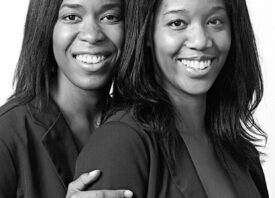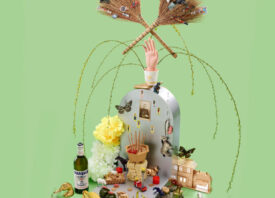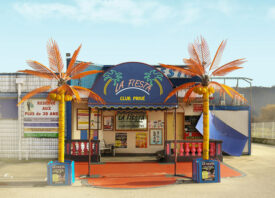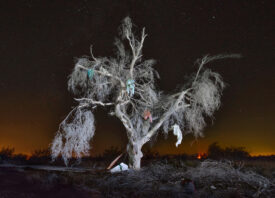Search this site
François Brunelle’s Doppelgänger Photos Changed His Life


“This project made me realize who I was,” François Brunelle tells me. Since 2000, the artist has been seeking out—and photographing—unrelated “look-alikes” who could pass for identical twins. Most of them have never met before stepping into his studio, and some live thousands of miles apart.
As it happens, the artist eventually found his own doppelgänger while working on the project. “Perhaps we all have a desire to be close to someone who looks like us,” he reflects. “I think maybe we hope that this person is, in fact, a little bit like us.” The project has traveled the world and led to scientific research: last year, one study revealed that the “look-alikes” who look most similar actually share more genes than those who look less alike.
“This project has helped me to find at least five hundred new friends (the look-alikes in my collection), plus a lot of interesting people (journalists and scientists),” Brunelle says now. I’m Not a Look-Alike! has caught the attention of multiple generations now; in the internet age, where everything seems fleeting, this is one project that endures.
Brunelle’s portraits present questions about what it means to be human and how we relate to one another. Sometimes, the project has even gone so far as to answer those questions, though it almost always sparks new ones along the way.

When you embarked on this project, almost 25 years ago, did you have any idea where it would take you?
François Brunelle: My goal was always to do a book, on which I am seriously working right now, and a major exhibition. But I never expected to be published all over the world like it has been.

How did you first find people to be part of the project in the beginning?
François Brunelle: Over the years, I had noticed some pairs of look-alikes in my everyday life. When I started the project, I contacted them. Some of those whom I could reach posed for the photos, and then, after about eight or nine couples, I was out of subjects. I had the idea of asking the media for help since the internet was exploding at the time. That allowed me, thanks to journalists all over the world, to reach out to many possible doppelgängers for the project.

As the project grew, did your approach change at all?
François Brunelle: I don’t think so. Only the technique evolved a little bit, as I transitioned from traditional film to digital media. I create the newest photos exactly as I did the first, each time being insecure about the outcome.

Can you walk us through a typical portrait session? How much time do you spend with each pair of doppelgängers?
François Brunelle: The photos are done either in my studio or a different location. This location can be another studio or simply in a hotel room. There is nothing complicated. I work alone with the models (except when there is media involved or when I participate in special projects and filming by another party is involved).
It is a very private thing, with no hair and make-up (except when filmed). I like it very casual, a little photo session between friends. We are in this together, the three of us trying to achieve something, quietly, without any fuss. First, we sit down after introducing ourselves, and then we discuss what will happen.
I read the model release aloud; it is very simple and protects both sides of the agreement, to make sure there is absolutely no misunderstanding. We look at the clothing that the models brought with them, if any, and start making the photos. The whole process takes anywhere from one and a half to two hours maximum, including a change of clothing, if it is possible.

What’s your most powerful memory from your time working on this project?
François Brunelle: Every one of the photo sessions is great and powerful. And frightening at the same time. I can never predict the outcome of a photo session. The only thing I can do is give my very best.
This idea of “likeness” is very elusive. Some people come to me because they are convinced that they look the same, and I just have to believe them. Along the way, I’ll then need to discover what that likeness is and how to capture it. A lot of it is a matter of faith.


Last year, your work led to a scientific discovery about doppelgänger DNA (people who looked more alike were found to share more genes). Can you tell us more about this?
François Brunelle: There are, in fact, several research projects connected with the series. I get contacted by researchers from time to time for all kinds of projects related to similarities between individuals.
The very first one was Ulrich Ettinger, who was with McGill University (Montréal) at the time and now in Bonn University (Germany). His study was about psychological similarities between doppelgängers. He was joined by Nancy Segal from Fullerton University (California). You can read about that in The New York Times.
Then there was Manel Esteller Badosa from Barcelona University, who, with my help and photos, did the DNA research you’re referring to here. He just wrote to me one day and was very insistent. I had my doubts in the beginning. Asking the subjects of my photographs to give away a sample of their DNA seemed a little bit far-fetched.
After a couple of meetings in Barcelona and Madrid with Esteller, I knew I could trust him and his fellow researchers, so I decided to help him in his research. And I am very glad now that this study, which took years to complete, is out. The results are fantastic, and you can read about them in another New York Times article.
I am very proud that my little personal project, done in all simplicity, was able to be a part of something bigger. That is very satisfying. Also, it helped to spread my work around, which is in itself the biggest reward for an artist.

Some of the doppelgängers have remained in touch, right?
François Brunelle: I am not sure how many people stayed in contact after the photo sessions. But I know for certain that one of the pairs did. One of them was a TV personality, and the other one was often mistaken for the other and asked for autographs. When they met for the first time in front of my camera, they realized that their spouses had the same first name, and they both had a son of the same age. So they started to go out together.

What tips do you have for emerging photographers hoping to find the kind of global success you did? How did you do it?
François Brunelle: I am not good at giving advice. but one thing I can say is to do something that you really want to do, something in which you truly believe, without calculating too much. You have to be smart and push your images to be seen and hope for the best. A lot of it is a matter of luck.
I looked honestly at my photos at the beginning of the project and thought they were quite ordinary. I told myself, though: these images are kind of boring and un-sexy, but if there is one person, only one, in the world who will like my images as much as I do, then I will be happy. I was doing these photos to please something authentic in myself, not caring so much about what people would think.

What are you working on now?
François Brunelle: I am working intensively on a book. I have been turned down by a few great editors, and I may self-publish it if I can. The fact that it will be the very first book on the subject makes things a little bit complicated because you cannot compare it to anything else that’s already out there. But then, I have to take that as an advantage. Once published, I will try to find a good museum, willing to embark on an international expo of the images.
You can follow the evolution of the project over on Instagram at @francoisbrunelle.doubles.

Further reading:
• Remarkable Portraits of Complete Strangers Who Could Be Identical Twins
• Enchanting Portraits of Identical Twin Farmers in the Hungarian Countryside
• Spirited Portraits from the World’s Largest Gathering of Twins



